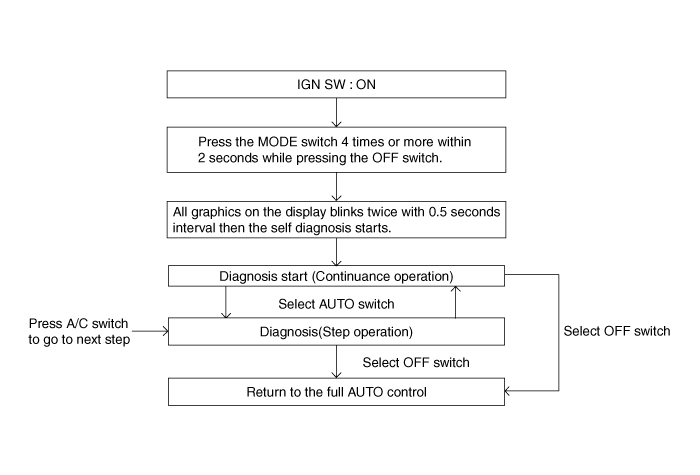Self-diagnosis process

Self-diagnosis process

How to read self-diagnostic code
During the self-diagnosis, the corresponding fault code flickers on the setup temperature display panel every 0.5 second and will show two figures.
Fault codes are displayed in numerical format.
Display | Fail description |
00 | Normal |
11 | In-car sensor open |
12 | In-car sensor short |
13 | Ambient temperature sensor open |
14 | Ambient temperature sensor short |
15 | Water temperature sensor open |
16 | Water temperature sensor short |
17 | Evaporator temperature sensor open |
18 | Evaporator temperature sensor short |
19 | Temperature door potentiometer open/short |
20 | Temperature door potentiometer fault |
21 | Mode door potentiometer open/short |
22 | Mode door potentiometer fault |
25 | Intake door potentiometer open/short |
26 | Intake door potentiometer fault |
Fault code display
Continuance operation: DTC code is none or one.

Continuance operation: DTC code is two or more.

STEP operation
Normal or one fault code is same as a continuance operation.
DTC code is two or more.

If fault codes are displayed during the check, inspect malfunction causes by referring to fault codes table.
Fail safe
No | Sensor | Fail condition | Fail safe function |
1 | In-car sensor | < 0.1V or > 4.9V | 23℃ (73.4℉) |
2 | Ambient temperature sensor | < 0.1V or > 4.9V | 20℃ (68℉) |
3 | Evaporator temperature sensor | < 0.1V or > 4.9V | -2℃ (28.4℉) |
4 | Temperature control actuator feedback | < 0.1V or > 4.9V | ● Setting temperature is 24.5℃ (76.1℉) or below: Max cool ● Setting temperature is 25.0℃ (77℉) or above: Max hot |
5 | Mode control actuator feedback | < 0.1V or > 4.9V | ● Vent: Vent ● Others: Defog |
6 | Intake actuator feedback | < 0.1V or > 4.9V | ● Recirculation: Recirculation ● Others: Fresh |
10 | Engine coolant temperature | < 0.1V or > 4.9V | 85℃ (185℉) |